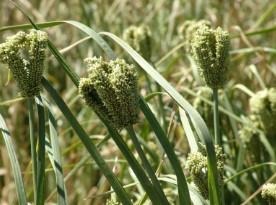By Kaine Korzekwa
The grain called finger millet may not be well-known outside of Africa, but it is an important crop to the region. Finger millet has been farmed in eastern Africa for thousands of years. However, breeding the crop for better traits has been difficult for local farmers.

This image shows healthy finger millet plants in a field trial in Ethiopia. Finger millet is a well-known and important crop grown in Africa.
Katrien Devos, a professor at the University of Georgia, and her colleagues are collaborating with scientists from Kenya to improve the grain’s yield and quality. “Breeding has traditionally been done, and is still often done, by selecting improved lines within existing cultivars,” she explained. “Breeders essentially rely on occasional spontaneous outcrossing events in which pollination occurs with pollen from a nearby growing variety rather than self-pollen to generate new combinations. We have been working with breeders in eastern Africa to bring finger millet breeding into the 21st century."
This study was published in the Plant Genome Journal, a publication of the Crop Science Society of America.
The team set out to find a way to provide breeders with better tools to improve millet traits in a targeted way. This meant digging into the DNA of finger millet to find genes that are responsible for beneficial traits. This is no easy task, says Devos.
The researchers used a technique called genotyping-by-sequencing. This is a form of sequencing where a small portion of the genome is sequenced that represents the broader whole. This saves time and money and allows the researchers to have enough data for genetic mapping. This mapping allowed them to find potential genes or areas on the genome responsible for certain traits, called quantitative trait loci.
Click here to see more...